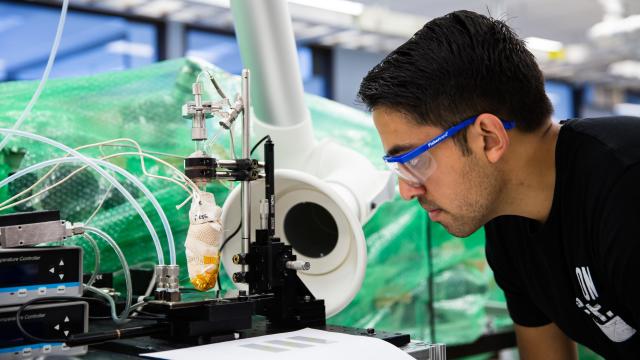A graduate student prints fluorescein crystals onto a cooled glass plate using organic vapour jet printing. Image: University of Michigan
Imagine that every time you needed a prescription, you wandered on over to the pharmacy and a pharmacist printed you up your drugs on the spot. On-demand micro manufacturing would allow pharmacists to customise for dosage, for your own personal biology, or even to combine many pills into one dose. It’s a vision for the future of pharmaceuticals that a growing number of scientists hope will make drugs cheaper, personalised and more accessible to far-flung places.
Now, a new method for “printing” drugs could bring that dream closer to reality. Researchers at the University of Michigan have invented a technique that they say can print precise doses of multiple drugs onto a variety of surfaces. One day, they report in a new study in the journal Nature Communications, the technique could lead to on-the-fly printing of custom medications at pharmacies, hospitals and other locations.
“We can print medicine directly onto essentially anything you want,” lead author Max Shtein told to Gizmodo. “We even did it on a Listerine tab.”
Shtein’s group is not the first to dream of printing medicines. At the University of Glasgow in Scotland, chemist Lee Cronin has demonstrated the early stages of what he hopes will eventually allow doctors to 3D-print medicine with ease, using a 3D printer to initiate chemical reactions that create drugs.
At MIT, Jose Gomez-Marquez is working on a different approach to the same idea, seeking to create something like a Keurig for pharmaceutical drugs that would allow pharmacists, or perhaps one day in the distant future even consumers, to assemble drugs from pre-packaged basic components. And at Harvard’s Wyss Institute, biochemist Peter Nguyen is developing a system for medical field operatives to make life-saving drugs that he likens to making a Cup of Noodles.
The list of incentives for such approaches is long. For one, it could allow drugs to be more easily transported to difficult locations, like war zones or rural areas, where some drugs are hard to obtain because it is difficult to keep them stable during transportation. Some hope the IKEA approach to pharmaceuticals could lead to lower costs. And the much-hyped coming era of personalised medicine will require that there is a simple, low-cost, local way to manufacture small amounts of substances tailored to individuals.
The advance that Shtein and his colleagues seem to have achieved is in their methodology. Shtein’s background is in semiconductors and chemical engineering, and he sought to apply techniques of electronics manufacturing to pharmaceuticals. The system hinges on vaporizing and then jetting the molecules that make up a drug’s active ingredients.
“You start with a pure material, often a powder and heat it up until it begins to evaporate. Then you pick up that vapour with a stream of nitrogen gas and send this gas mixture through a tube at high speed onto a surface,” he explained. “The the vapour condenses on the material, just like condensation on a bathroom mirror, but very controlled. That coating is basically your drug.”
The researchers tested drugs for cancer specifically, as well as other drugs, but they said the technique should work to produce any number of compounds — including those that are not soluble enough to work with current drug production methods. In other words, this could eventually lead to new drugs.
A major advantage, he said, will be the ability to control dosing.
“A doctor prescribes a certain amount of a drug not because it is the right amount to take but because that’s the number of milligrams it comes in,” he said. “This allows the ultimate tune-ability.”
Gomez-Marquez, of MIT, said the work was an important advance.
“This is *good* work,” he told Gizmodo via email. “The team at Michigan are conservative in their claims. I think that the notion of vapour deposition is an exciting evolution.”
It will still be many years before pharmacies stock anything like a vapour printer, and even more years before its safe to DIY your own pharmaceuticals at home. But such a future seems more imaginable by the day.
“If you look at your phone, you have the same phone as 10 million other people but it’s unique because of the apps you’ve got on it,” Shtein told Gizmodo. “We’re inching towards that paradigm with medicine. This technology unlocks those possibilities.”
